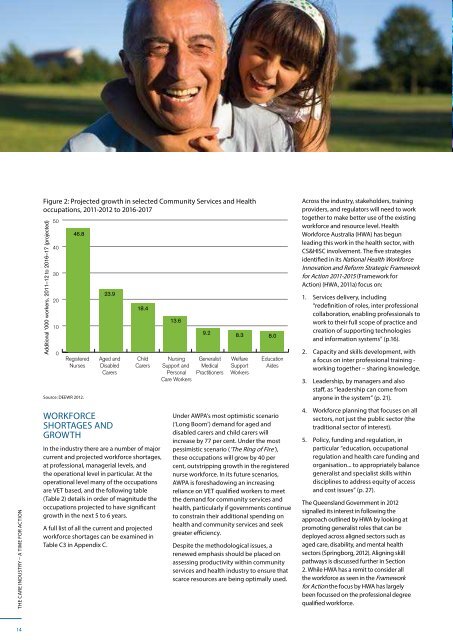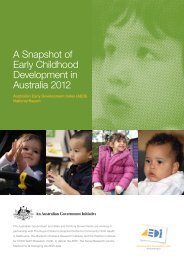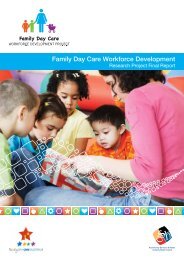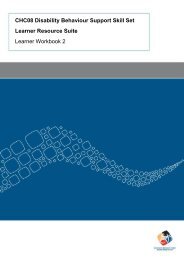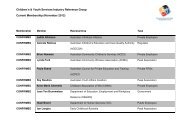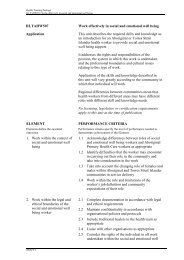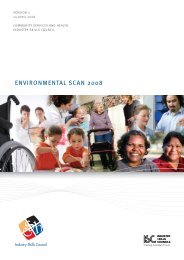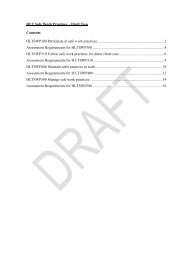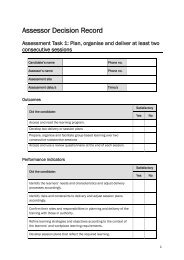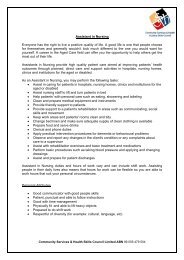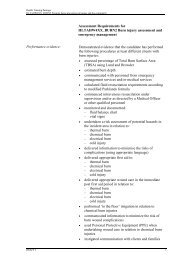2013 Environmental Scan - Community Services & Health Industry ...
2013 Environmental Scan - Community Services & Health Industry ...
2013 Environmental Scan - Community Services & Health Industry ...
Create successful ePaper yourself
Turn your PDF publications into a flip-book with our unique Google optimized e-Paper software.
THE CARE INDUSTRY – A TIME FOR ACTION<br />
Figure 2: Projected growth in selected <strong>Community</strong> <strong>Services</strong> and <strong>Health</strong><br />
occupations, 2011-2012 to 2016-2017<br />
Additional ‘000 workers, 2011–12 to 2016–17 (projected)<br />
50<br />
40<br />
30<br />
20<br />
10<br />
0<br />
46.8<br />
Registered<br />
Nurses<br />
Source: DEEWR 2012.<br />
23.9<br />
Aged and<br />
Disabled<br />
Carers<br />
WORKFORCE<br />
SHORTAGES AND<br />
GROWTH<br />
18.4<br />
Child<br />
Carers<br />
In the industry there are a number of major<br />
current and projected workforce shortages,<br />
at professional, managerial levels, and<br />
the operational level in particular. At the<br />
operational level many of the occupations<br />
are VET based, and the following table<br />
(Table 2) details in order of magnitude the<br />
occupations projected to have significant<br />
growth in the next 5 to 6 years.<br />
A full list of all the current and projected<br />
workforce shortages can be examined in<br />
Table C3 in Appendix C.<br />
13.6<br />
Nursing<br />
Support and<br />
Personal<br />
Care Workers<br />
9.2 8.3 8.0<br />
Generalist<br />
Medical<br />
Practitioners<br />
Welfare<br />
Support<br />
Workers<br />
Education<br />
Aides<br />
Under AWPA’s most optimistic scenario<br />
(‘Long Boom’) demand for aged and<br />
disabled carers and child carers will<br />
increase by 77 per cent. Under the most<br />
pessimistic scenario (‘The Ring of Fire’),<br />
these occupations will grow by 40 per<br />
cent, outstripping growth in the registered<br />
nurse workforce. In its future scenarios,<br />
AWPA is foreshadowing an increasing<br />
reliance on VET qualified workers to meet<br />
the demand for community services and<br />
health, particularly if governments continue<br />
to constrain their additional spending on<br />
health and community services and seek<br />
greater efficiency.<br />
Despite the methodological issues, a<br />
renewed emphasis should be placed on<br />
assessing productivity within community<br />
services and health industry to ensure that<br />
scarce resources are being optimally used.<br />
Across the industry, stakeholders, training<br />
providers, and regulators will need to work<br />
together to make better use of the existing<br />
workforce and resource level. <strong>Health</strong><br />
Workforce Australia (HWA) has begun<br />
leading this work in the health sector, with<br />
CS&HISC involvement. The five strategies<br />
identified in its National <strong>Health</strong> Workforce<br />
Innovation and Reform Strategic Framework<br />
for Action 2011-2015 (Framework for<br />
Action) (HWA, 2011a) focus on:<br />
1. <strong>Services</strong> delivery, including<br />
“redefinition of roles, inter professional<br />
collaboration, enabling professionals to<br />
work to their full scope of practice and<br />
creation of supporting technologies<br />
and information systems” (p.16).<br />
2. Capacity and skills development, with<br />
a focus on inter professional training -<br />
working together – sharing knowledge.<br />
3. Leadership, by managers and also<br />
staff, as “leadership can come from<br />
anyone in the system” (p. 21).<br />
4. Workforce planning that focuses on all<br />
sectors, not just the public sector (the<br />
traditional sector of interest).<br />
5. Policy, funding and regulation, in<br />
particular “education, occupational<br />
regulation and health care funding and<br />
organisation... to appropriately balance<br />
generalist and specialist skills within<br />
disciplines to address equity of access<br />
and cost issues” (p. 27).<br />
The Queensland Government in 2012<br />
signalled its interest in following the<br />
approach outlined by HWA by looking at<br />
promoting generalist roles that can be<br />
deployed across aligned sectors such as<br />
aged care, disability, and mental health<br />
sectors (Springborg, 2012). Aligning skill<br />
pathways is discussed further in Section<br />
2. While HWA has a remit to consider all<br />
the workforce as seen in the Framework<br />
for Action the focus by HWA has largely<br />
been focussed on the professional degree<br />
qualified workforce.<br />
Given the composition of the health<br />
workforce now and into the future, more<br />
emphasis must be placed on health<br />
professionals who are VET qualified and<br />
constitute the majority of the community<br />
services and health industry workforce.<br />
Examining jurisdictions where demand<br />
driven funding has been introduced, recent<br />
trends suggest that demand for personal<br />
services courses is coming at the expense<br />
of areas of critical shortage, such as health.<br />
CHANGES TO<br />
THE VET MARKET<br />
In April 2012, the Australian Government<br />
and all State and Territory governments<br />
signed a revised version of the National<br />
Agreement for Skills and Workforce<br />
Development, committing them to<br />
introduce a national ‘entitlement’ up to<br />
Certificate III that can be used by any<br />
provider, public or private (COAG, 2012).<br />
States and Territories are moving to<br />
implement these reforms.<br />
The preliminary evidence from Victoria,<br />
which was the first State to introduce<br />
an entitlement model, is that this has<br />
led to an increase in publicly funded<br />
enrolments in community services and<br />
health qualifications. However, it has also<br />
led to concerns within industry about the<br />
regulation of new entry training providers<br />
to the VET sector and the quality of<br />
training (Wheelahan, 2012). These effects<br />
are covered in more depth in Section 3<br />
(Current Impact of Training Packages).<br />
Table 2: <strong>Community</strong> <strong>Services</strong> and <strong>Health</strong> current occupation numbers<br />
and projected numbers and percentages<br />
ANZSCO<br />
Occupation<br />
†<br />
Nov 2011<br />
‘000<br />
ˆ2016-17<br />
‘000<br />
ˆ% change<br />
2011-2016/17<br />
2544 Registered Nurses 228.0 274.8 20.5<br />
4231 Aged and Disabled Carers 3 116.8 140.6 20.4<br />
4211 Child Carers 3 115.1 133.4 16.0<br />
4233 Nursing Support and Personal<br />
Care Workers 3 82.1 95.6 16.5<br />
4221 Education Aides 3 80.4 88.4 9.9<br />
2231 Human Resource Professionals 4 61.2 68.9 12.5<br />
4117 Welfare Support Workers 3 56.2 64.6 14.8<br />
2531 Generalist Medical Practitioners 52.3 61.5 17.7<br />
6214 Pharmacy Sales Assistants 5 34.6 36.2 4.6<br />
3112 Medical Technicians 3 28.1 32.4 15.3<br />
4114 Enrolled and Mothercraft Nurses 3 27.5 30.6 11.0<br />
2726 Welfare, Recreation and<br />
<strong>Community</strong> Arts Workers<br />
2513 Occupational and <strong>Environmental</strong><br />
<strong>Health</strong> Professionals<br />
26.0 29.5 13.7<br />
24.5 27.8 13.7<br />
2725 Social Workers 22.2 25.7 16.0<br />
2512 Medical Imaging Professionals 22.0 25.3 14.8<br />
2723 Psychologists 21.9 25.3 15.4<br />
2515 Pharmacists 21.1 23.1 9.9<br />
4232 Dental Assistants 3 20.9 23.2 11.0<br />
2411 Early Childhood<br />
(Pre-primary School) Teachers<br />
20.3 22.3 9.9<br />
2346 Medical Laboratory Scientists 19.9 21.2 6.2<br />
Source: † Nov 2011 from ABS Census of Population and Housing, 2006 and 2011. ˆ2016-17 and % change 2011-<br />
2016/17 from DEEWR, Occupational projections, http://www.deewr.gov.au/lmip/default.aspxLMIP/Publications/<br />
<strong>Industry</strong>EmploymentProjections.<br />
Notes: <strong>Community</strong> <strong>Services</strong> and <strong>Health</strong> occupations are defined as occupations in which the majority of employment is in the<br />
<strong>Health</strong> Care and Social Assistance industry and/or which are identified in training.gov.au as aligned to a qualification from the<br />
<strong>Community</strong> <strong>Services</strong> or <strong>Health</strong> Training Packages (see Appendix E:Table E1).<br />
ENVIRONMENTAL SCAN <strong>2013</strong> : SECTION ONE LATEST INTELLIGENCE<br />
14 15


